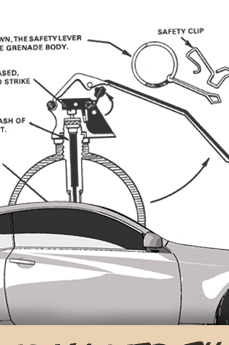Lets get some basics out of the way first. Number one - get a good blow-off valve kit (get a throttle-side kit if you're putting in an aftermarket turbo); Synapse Engineering if you can afford it, otherwise HKS or TiAL will do you justice. Buy from the reseller that gives you the most reacharound.
Number two - get an intercooler kit that doesn't suck. Ergo, anything but CX Racing, Mishimoto or a $200 Ebay kit would be a good idea. Known quality kits include Greddy, Depo Racing, AEM, Garrett, etc so on and so forth. You know where to shop.
We will first discuss building a DIY turbo upgrade - this means you select all your own parts and build your bigger, better turbo setup your way on your budget. If you find that idea frightening and you're clutching a stuffed animal or your wife right now, please skip to the bottom where we discuss kits.
NOTE: Turbo "kits" or "OEM-fit drop-in turbos" that mount to the first generation car's OEM turbo manifold, as well as OEM turbo "upgrades" are not discussed here at all because I consider them a complete waste of money. The OEM turbo is such a joke, spending even a dime on it will only lead to a craving for actual power somewhere down the line. Larger turbos that fit onto the OEM TD04 flange manifold are basically bottlenecking greatness without discounting the price; e.g., the stock manifold is a tiny little flange that does not lend itself to big turbo builds. Second generation (2013- ) cars' OEM turbo hotsides are cast as one piece with their exhaust manifolds - meaning you got one choice and one choice only - manifold + aftermarket turbo upgrade. Luckily for you Hyundai made the choice for you and you'll never be tempted to throw your hard earned cash away on a tiny stock turbo 'upgrade'.
Parts you will need to accompany your newer, larger turbo: Larger fuel injectors, intake, downpipe to match the turbo, intercooler, blow off valve, 1-step colder spark plugs, port and polish intake manifold or a whole new, equal-length runner intake manifold (if you can make one), a new clutch & flywheel that isnt made of bubblegum, and if you're going for 400whp+, brother you better build your block.
Stock Turbo Wastegate Mod Warning
You have likely seen or heard of the "stock wastegate mod" on the first gen car's turbo, which means manually adjusting the wastegate actuator arm. Do not under any circumstances do this if you want your turbo to live long and prosper, or function properly. This goes doubly for you if you've flash tuned your stock turbo car. The ECU controls the stock turbo's wastegate (and therefore boost) using a computer-controlled solenoid that is operated by a duty cycle table in the ECU software. The duty cycle is written in aftermarket flash tunes and obviously the OEM tune based on OEM wastegate acutator tension/length of throw. Do not fuck with it.
If you upgrade to a Man-Size turbo, go for the gold, buy a badass gold-plated wastegate and tune away, but if you stick with a first generation stock turbo, leave it alone, it was engineered to operate the way it is. Buying an aftermarket "upgraded" wastegate actuator for your stock turbo is a monumental waste of money. The OEM wastegate is very tiny and poorly-suited to producing usable boost characteristics above OEM boost levels.
Second generation cars may see mild gains upgrading their wastegate actuators, if they can figure out a way to deal with the fact that their OEM wastegates are controlled electrically...
Personalized & Perfect: The way you want it (if you have a clue)
If you don't clearly understand how and why a turbocharger works, please go here. Before you consider even touching your turbocharger, monkeying with it, doing that silly wastegate "DIY mod" you heard about on the forum, you had better know why your turbocharger does what it does, and how.
In a nutshell if you are reading this sentence, and the word wastegate means nothing to you, stop, and go learn. Hopefully if you have chosen this route, this isn't your first Roman orgy and you are well prepared to fend off venereal disease and have a great time.
First and second generation 2.0T BK cars have two different turbochargers. The second generation car's turbo is actually fairly respectable and can make about 300whp with just bolt-ons and a canned tune from the usual Korean suspects. The first generation's turbo is useful only as an implement of social revolution, in that it may admirably smash through someone's office window with aplomb one day. Aside from that the 2010-2012 turbocharger is pretty much a joke, delivering at most 270whp on a seriously peaky tune. When I say peaky, I mean it can't hold max boost for very long, tapers off and is basically a light switch.
Now that you've decided to put on your big boy pants and make real power with your car, and you've clicked on the "turbo" page of this guide, lets get started. Upgrading the housing/wheels of your first generation turbo is more pointless than writing roadmaps for peace in the Middle East; it's a lost cause - the factory turbo is good at making good fuel mileage and allowing the car to actually begin moving forward in a reasonable period of time, that's it.
On the first gen car, the OEM turbo manifold is a fairly restrictive, tiny little TD04 flange; there's not much room here to amp up the boost and shove metric ass tons of exhaust gas into a larger turbo, therefore, make some artwork out of it, huck it into the trash, or give it to unwanted house guests. With a BK I if you are going to build your own turbo setup by hand rather than buy a complete kit (which can be slightly cheaper/more personally configured), your first and immediate course of action should be to purchase either a Beyond Redline T3 cast manifold, or if you are a baller with deep pockets who knows what he's doing, you need to buy a tubular manifold like PTuning's V-band manifold, or a twin-scroll manifold of your choice. A twin scroll manifold is one that feeds pulse-matched ports based on firing order into two exhaust ports on a turbo flange such that the inducer wheel receives nearly constant feed of exhaust gas and spools as quickly as possible. PowerLabs was known to have made a twin-scroll V-Band manifold at one time though I myself cannot find anywhere to buy one. Twin scroll manifolds must be used with (duh) twin scroll turbos only.
Tubular manifolds typically offer superior flow characteristics, potentially higher spool-up speeds being twin scroll, higher 'wow' factor in your engine bay - but make no mistake, the Beyond Redline T3 cast manifold (it's manufactured by Design Engineering Incorporated, also seen online as "SPA Turbo") is the best possible bet both price-wise and feature-wise for 9/10 builds. This is because cast manifolds last longer and will not fatigue and 'sag' over time with heat stress like a tubular manifold eventually will do - the welds will one day sag and fatigue over time. Granted, its probably going to be a helluva long time, but still. A quality tubular manifold will cost you between $500-1200 depending on who makes it, what its made of, if it's twin scroll, if it has a dump pipe, v-band fittings, etc etc.
Obviously an aftermarket turbo will necessitate a new downpipe be made to mate your turbo's hot side to the exhaust; this is cheaply done by practically any exhaust shop as long as you can provide them with an exhaust flange that matches your turbo.
What is a dump pipe? Your turbocharger will be either internally or externally gated; e.g. the wastegate will sit on a separate exhaust port coming off the manifold, or the turbo will incorporate a wastage internally in the hotside housing. Either will work well for pretty much any build though external is ideal for massive power builds and builds that are trying to get as finely tuned as they can get. Regardless, your wastegate will throw exhaust out a separate path than the exhaust when it is open- it will then need to be routed back into the exhaust pipe so the exhaust gas goes out the full exhaust tract, or you can simply dump the wastegate right out it's own little dump pipe. You've probably had a Dodge Neon SRT-4 pass you (pretty frequently, if you drive a stock Genesis 2.0T) and heard an ungodly loud sound at full boost, and when the car idles it sounds like it's sharting itself; that's a dump pipe. It's also referred to by some as an "O2 dump". By dumping all exhaust gasses with as little restriction as possible in this manner, the turbo is relieved of as much exhaust backpressure as possible, allowing it to spool as quickly as possible, allowing it to make as much boost as possible. Typically open dumps will yield spool-up characteristic changes you may not notice very easily vs. a fullback exhaust route, though the more boost you dial in, the more difference you will notice.
Which turbocharger should I use? The one you want. Choose your type of turbocharger based on what the car is being built for. I will refer to turbocharger types using Garrett/Honeywell and sometimes Mitsubishi nomenclature, if you don't understand the names or they mean nothing to you, go to Garrett Turbo's website and become educated. This is considered common knowledge in tuning and if you're not familiar with these terms you shouldn't be messing with handbuilt turbo builds. Bear in mind the power ranges I'm listing for the turbo size ranges are very very fuzzy and depend entirely on turbo brand, build quality, tuning, and your mother's maiden name.
~GT28/16G - 300-330whp
~GT30/20G - 350-500whp
~GT45 and up - 500-HolyShit
NOTE: When shopping for a good turbocharger, wastegates, the hardcore stuff of boost - Forced Inductions Online is a choice vendor to deal with due to their experience in turbo cars, and their relationships with high-end turbo component vendors & suppliers.
These are just some of the many available sizes of turbochargers, there are thousands of options and brands, these are just fuzzy numbers. The larger the turbo, the more top end power it will make, and the longer it will take to spool. Most drivers consider a GT30-ish turbo the largest they will want to run on a 2.0L street car because anything larger is typically considered unacceptable/not-fun turbo lag. If you've sustained massive cranial trauma or you got body checked by a Mack Truck as a kid, and you've decided to build a Drag Racing car out of your Genesis, then go for the largest snail you can lay your hands on and drop that clutch as late as possible. Just don't come crying to anyone when you make a fool out of yourself on the drag strip with a car that is so poorly set up for drag racing Roseanne Barr wouldn't need a handicap to compete on foot.
Remember that if you use a top-mount manifold, your turbocharger now sits right where it was never designed to be, emitting an incredible amount of heat. It is up to you, Mr. Expert, to heat shield anything near the turbocharger and ventilate your hood either by spacing it up at the rear using the tried & true Home Depot washer trick or buying a vented aftermarket hood. Ceramic-coating your turbo's hot side and your manifold (and downpipe while you're at it) will cut down emitted heat in the engine bay a bit and keep heat inside the turbo, where it wants to be. This has been known to help with spool up to some extent as well. Heat wrap does the same job but not as well. Wrap can also catch fire if you're a dumbass and you don't wrap your shit correctly.
NOTE: Twin scroll turbochargers and turbos that are built with high-grade bearings and turbine/inducer wheels will spool up much more quickly and spin faster, longer. Look for ceramic ball bearings, multi-ball bearing, inconel wheels, and the highest possible price tags to get the best turbos. With turbochargers you always get what you pay for.
Simple and Painless Drop-in Kits (in theory)
A variety of manufacturers offer drop-in turbo kits; due to the wide variety available I will simply name brands that are known and established, though others do exist and these kits can be had via the manufacturers or some distributors. First we will list off what a good kit should include -
- Turbocharger
- Exhaust manifold
- Downpipe
- Intake & filter
- Coolant/Oil lines & fittings
- Wastegate (if not internal)
- All charge piping
- Intercooler
- Blow off valve & fittings
- Fuel injectors (matches turbo power range)
- Canned ECU flash-tune or replacement ECU with pre-loaded tune
Some kits may include options above and beyond the call of duty such as one step colder spark plugs, a fullback exhaust, options for dump pipes, heat shielding, ceramic coating options, or a few other bells & whistles you would typically handle on your own.
The biggest most pressing question you need to ask any kit provider is - how am I tuning this?
The value in a pre-made turbo kit is the fact that the research has already been done, the result is a known power range, it's known safe on a stock block (or it's known a build block is required) and nearly all variables have been eliminated.
Known quality kits exist from a number of vendors, and again you get what you pay for. Buy a kit based on a few basic factors - is it in my desired power range, and is the tuning supplier local/easy to get to for tweaks or if I upgrade later?
Full Kits are available from the following vendors, as well as others that are unlisted (or shady, and not recommended!)
- TurboXS
- BTRCC
- Beyond Redline
- Custom Performance Engineering (CP-E)
If you are choosing the kit route, and you are not thoroughly educated in turbocharger use, installation and application, for the love of God hire a professional to do ALL the work FOR YOU.

































